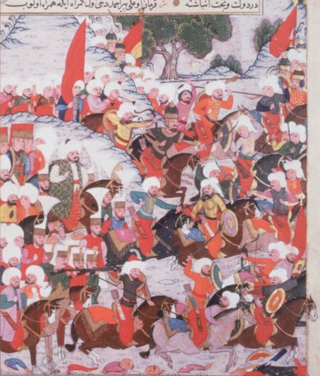Related Research Articles

Mehmed II, commonly known as Mehmed the Conqueror, was twice the sultan of the Ottoman Empire from August 1444 to September 1446 and then later from February 1451 to May 1481.

The Karamanids, also known as the Emirate of Karaman and Beylik of Karaman, was one of the Anatolian beyliks, centered in South-Central Anatolia around the present-day Karaman Province. From the mid 14th century until its fall in 1487, the Karamanid dynasty was one of the most powerful beyliks in Anatolia.

The Battle of Otlukbeli or Otluk Beli was a battle between Aq Qoyunlu and the Ottoman Empire that was fought on August 11, 1473.
Karamani Mehmet Pasha was an Ottoman statesman who served as Grand Vizier from 1477 to 1481.
Ishak Pasha was an Ottoman general, statesman, and later Grand Vizier of Albanian or Greek origins.
Ibrahim II was a bey of Karaman. In 1425 he married Ilaldi Sultan Hatun, a daughter of Ottoman Sultan Mehmed I. They had six sons among them Ishak Bey, Pir Ahmet Bey and Kaya Bey, who married his cousin Hafsa Hatun, daughter of Murad II, and had a son, Kasım Bey.
The Abaza rebellion is the name given to uprisings that occurred in the 17th century in the Ottoman Empire during the reigns of Mustafa I (1622–23) and Murat IV (1623–40). The name of the rebellion refers to Abaza Mehmet, an Ottoman pasha of Abkhazian origin. Sometimes, this event is considered as a part of the Jelali revolts. But unlike the other Jelali revolts the principal reason of the Abaza rebellion was the resentment towards the janissary corps.

Süleyman Çelebi was an Ottoman prince and a co-ruler of the Ottoman Empire for several years during the Ottoman Interregnum. There is a tradition of western origin, according to which Suleiman the Magnificent was "Suleiman II", but that tradition has been based on an erroneous assumption that Süleyman Çelebi was to be recognised as a legitimate sultan.
Nasiraeddin Mehmed II of Karaman, also Mehmed Beg, Mehmed Beg II or Nasir al-Din Mehmed Beg was the Bey ruler of Karaman. His mother was Nefise Hatun, a daughter of Ottoman Sultan Murad I.
Afshar Beylik was a Turkoman beylik (principality) in Eastern Anatolia in the early 16th century. It was founded by the Afshar tribe which was an Oghuz Turkic tribe with Shia Muslim faith. The Afshar Beylik was the last of the Anatolian beyliks to be incorporated into the Ottoman Empire in 1534 during the Ottoman campaign.

Mehmet I of Karaman, also known as Şemseddin Mehmet, was the second bey of Karaman Beylik, a Turkish principality in Anatolia in the 13th century. His father was Karaman Bey.
Alaattin Ali of Karaman (d.1398), also Alaeddin Ali, was a bey of Karaman Beylik, a Turkish principality in Anatolia in the 14th century. Like most other Karaman beys, Ali Bey was a rival of the rising Ottoman Empire, and the two principalities engaged in chronic wars against one another.
Ishak of Karaman was a bey of the Karamanids, a Turkish principality in Anatolia in the 15th century.
Kasım of Karaman was the last bey of the Karaman Beylik, a Turkish principality in Anatolia in the 15th century.

Ottoman wars in Asia refers to the wars involving the Ottoman Empire in Asia. Ottoman Empire was founded at the beginning of the 14th century. Its original settlement was in the northwest Anatolia where it was a small beylik (principality). Its main rival was Byzantine Empire. In 1350s Ottomans were able to cross the Dardanelles strait and eventually they conquered most of the Balkans. Although they mainly concentrated their expansions in Europe, they also expanded their territories in Asia, mainly in Fertile Crescent and Arabian Peninsula.
Süleyman of Germiyan, also known as Şah Çelebi, was the ruler of Germiyan, an Anatolian beylik, between 1363 and 1388.
İzzettin İsfendiyar Bey, was a member of the Candar dynasty that reigned as bey from 1385 until his death in 1440. Although the name of the dynasty is Candar, following his reign, as a testament to its longevity certain historians of the Ottoman Empire also began to refer to the beylik by the name İsfendiyar.

The Battle of Turnadağ was an engagement between the forces of the Ottoman Empire and the Beylik of Dulkadir of Turkey in 1515.
Beylik of Tacettin was a small Turkmen principality in Anatolia in the 14th and 15th centuries.

Battle of Kıreli, phase in the Ottoman - Akkoyunlu and Ottoman - Karaman struggles.
References
- ↑ Prof. Yaşar Yüce-Prof. Ali Sevim: Türkiye tarihi Cilt I, AKDTYKTTK Yayınları, Istanbul, 1991 pp. 256–258
- ↑ Karaman History (in Turkish)